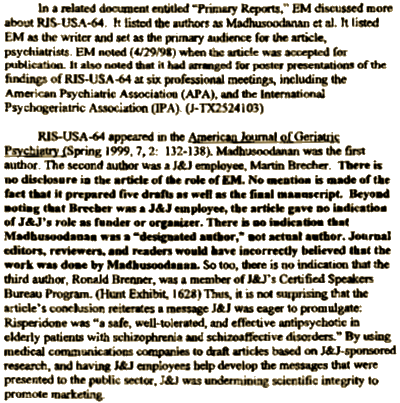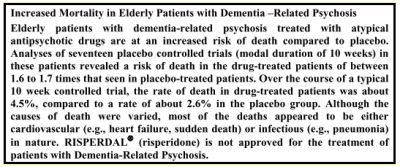Risperidone in the Treatment of Elderly Patients With Psychotic Disorders
by Madhusoodanan, Subramoniam M.D.; Brecher, Martin M.D., D.MS.c.; Brenner, Ronald M.D.; Kasckow, John M.D.; Kunik, Mark M.D.; Negron, Arnaldo E. M.D.; and Pomara, Nunzio M.D.
American Journal of Geriatric Psychiatry 7:132-138, 1999.
The authors evaluated the safety, tolerability, and efficacy of risperidone in 103 elderly patients [mean age, 71 years] with schizophrenia [75%] or schizoaffective disorder [25%]. Using the Extrapyramidal Symptoms Rating Scale [ESRS], Positive and Negative Syndrome Scale [PANSS], and Clinical Global Impression [CGI] scale, they conducted a prospective, open-label, 12-week trial in 14 psychiatric centers in the United States. Patients’ symptoms were assessed at baseline and over a 12-week period. At endpoint, ESRS scores were significantly reduced, as were PANSS total and subscale scores. There were no clinically significant changes in electrocardiograms, laboratory test results, or vital signs. Risperidone was well tolerated and efficacious in elderly patients with schizophrenia or schizoaffective disorder.
Who knew that ghost-writing of medical journal articles was even a topic in 1999? I didn’t. But in the Rothman Report [detestable…], we read this:

EM stands for Excerptia Medica:
Notice the amazing category, designated author. I guess that by 1999, the practice of a pharmaceutical company doing a study specifically oriented towards some marketing goal, having it written up by a medical communications firm like Excerptia Medica, then picking an author to legitimize the enterprise must’ve been pretty common. But I think most of us were oblivious:

On a lark, I put Dr. Subramoniam Madhusoodanan‘s name into Google® and found this:
Efficacy and Tolerability of Olanzapine in Elderly Patients with Psychotic Disorders: A Prospective Study
by Subramoniam Madhusoodanan, Ronald Brenner, Padma Suresh, Nancy M. Concepcion, Cesar D. Florita, Geetha Menon, Amarjit Kaur, Giovanny Nunez and Harsha Reddy
Annals of Clinical Psychiatry 12:1-18, 2000.
Olanzapine is a novel antipsychotic effective in reducing positive and negative symptoms of schizophrenia and with a safe side-effectproï¬le. Premarketing trials,however, included only a few elderly patients. Further data are needed regarding the effects of olanzapine in the elderly and those with comorbid medical illness. In this pilot study, 11 hospitalized patients (age range 60–85 years) who manifested symptoms of psychosis related to schizophrenia and schizoaffective disorders were treated with olanzapine (dose range, 5–20 mg/day). Efï¬cacy and safety were assessed by the Positive and Negative Syndrome Scale (PANSS), Clinical Global Impression Scale (CGI), Extrapyramidal Symptom Rating Scale (ESRS), Mini-Mental State Examination (MMSE), Calgary Depression Scale For Schizophrenia (CDSS), EKG, physical examination, and various laboratory tests.Seven patients responded to treatment and all of them showed improvement in both positive and negative symptoms, with greate rreduction in positive symptoms. Treatment was discontinued in 2 patients whose symptoms showed no improvement or worsened. The CGI showed signiï¬cant improvement in 9 patients, remained the same in 1, and worsened in 1 patient. ESRS showed signiï¬cant reduction from baseline to ï¬nal visit. Of the 10 patients who cooperated for MMSE, 9 had improved scores. The CDSS showed signiï¬cant reduction in scores from baseline to ï¬nal visit. No signiï¬cant changes were noted in laboratory tests, prolactin levels, EKG, and physical examination. Concomitant administration of lorazepam, carbamazepine, divalproex sodium, and lithium carbonate caused no adverse consequences. The reduction of positive and negative symptoms, lack of signiï¬cant extrapyramidal symptoms and other side effects, and lack of any signiï¬cant drug interaction suggest that olanzapine may be a safe and effective antipsychotic medication in the elderly.
This article had no conflict of interest declarations at all. But wait! there was more:
Experience with the Atypical Antipsychotics—Risperidone and Olanzapine in the Elderly
by Subramoniam Madhusoodanan, Padma Suresh, Ronald Brenner and Renuka Pillai
Annals of Clinical Psychiatry 11:131, 1999.
There is paucity of published data regarding controlled trials with risperidone and olanzapine in elderly psychotic patients. Medical records of 151 hospitalized geropsychiatric patients (risperidone patients n = 114 and olanzapine patients n = 37) were analyzed for demographic data, target symptoms, doses, effects, side effects, comorbid medical conditions and concurrent medications. The mean age of the patients was 71 years. The male: female ratio was essentially the same for both groups. The mean daily dose was 3 mg for risperidone and 10 mg for olanzapine. 78% of the risperidone group and 75% of the olanzapine group appear to have responded to treatment. The discontinuation rates of medication was the same in both groups (22%). Adverse events were reported in 16–17% in both groups. It appears from this study that both risperidone and olanzapine are relatively safe and effective in geropsychiatric patients with comorbid medical illnesses. Controlled studies and head-to-head comparison studies are recommended.
Another article with no conflict of interest declaration. This would be almost laughable if the stakes weren’t so high. Janssen [aided by Excerptia Medica] came on the scene with the new Atypical Antipsychotic, Risperdal, with a stealth campaign to sell the drug no matter what it took. In the TMAP project in Texas, they appear to have heavily influenced the State’s drug use policy in the public sector, and then moved into a number of other States. In this case, they’re trying to extend their indications into the elder-care market with a ghost-written article [one of many]. They picked a designated author who apparently was way more than available, a Dr. Subramoniam Madhusoodanan in New York. But the FDA didn’t buy it, thankfully. Not many years later, this warning was appended to all of the Atypical Antipsychotics:

I read this material and write about it, but it still strikes me as surreal – that they would actually do this kind of stuff. What were they thinking?…

Schizophrenia drugs like Olanzapine (Zyprexa) are risky and are frequently give *off label* I was prescribed Eli Lilly Zyprexa for PTSD and suffered permanent health damage.
Eli Lilly’s #1 cash cow Zyprexa drug sale $38 billion dollars to date has a greater risk of causing type 2 diabetes over the non-user of Zyprexa. So,here we have a conflict of interest that this same company also is a big profiteer of diabetes treatment.
—
Daniel Haszard
I often feel bad because I focus on the drugging of children so much that it must seem as if I have no sympathy for other vulnerable victims of these drugging schemes but it certainly is not the case. I skimmed over the ghostwritten studies on the elderly but I’ve been tracking down the names of the authors on the studies that were ghostwritten to pump up sales to kids to fit some of them in an article I’m working on now.
Please keep the great work because I’ve come to rely on your reporting and try to remember to check out your site every day to make sure I don’t miss anything.